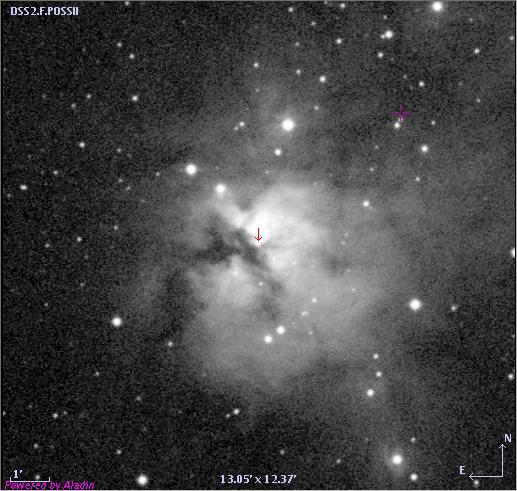
An optical image of the LkH-alpha 101 nebula, with an arrow pointing to the luminous young star. New results indicate that the relationship between the radio and X-ray radiation from this object is unlike that seen in the sun and more evolved stars, and still uncertain.
Magnetic fields play an important but poorly understood role in the formation and evolution of stars -- important because magnetic fields stretch around a hot medium like a rubber band and help to determine the flow of material onto or away from the star, and poorly understood because the fields are very difficult to measure. In our sun, magnetic fields heat the corona enough to produce X-ray emission, while also producing radio radiation as accelerated charged particles swirl around. Over the past twenty years, studies of evolved stars have uncovered that the radio and X-ray emission from them is correlated, although the details are poorly understood.
Newborn stars also emit at X-ray and radio wavelengths, but scientists have an even poorer understanding of if or how the two might be linked. For example, when a young star is still surrounded by a protoplanetary disk, its radio emission should be dominated by the disk rather than by the coronal activity on the star. Because magnetic fields are so important to the development of stars, and to the workings of our own sun in particular, astronomers are trying to piece together a comprehensive picture.
SAO astronomer Scott Wolk and his colleague have published the first simultaneous study of X-ray and radio emission from a cluster of young stars surrounding the B star, LkH-alpha 101. They looked for correlations in the short timescale variations (as short as about 30 minutes) as a probe of any connections. They found that young stars are surprising in several ways: even when they have disks, their radio emission can have the character of older stars without disks, and moreover the general trends of the X-ray and radio correlations are quite different in young stars. The scientists conclude that, at least in the LkH-alpha 101 cluster, the behavior of the magnetic field is not like that in older stars at all. In fact, they suggest that there is a different phenomenon at work in these X-ray emitting young stars, in which the regions emitting the X-rays and radio are physically and/or energetically distinct. The results are a significant step in understanding how magnetic fields shape a star's evolution from birth onward.